Jeep Cherokee (XJ): Removal and installation
REMOVAL (1) Remove steering column cover and lower trim
panel for switch access (if necessary).
(2) Press brake pedal downward to fully applied
position.
(3) Rotate switch approximately 30 in counterclockwise
direction to unlock switch retainer. Then
pull switch rearward and out of bracket.
(4) Disconnect switch harness and remove switch
from vehicle (Fig. 17).
1 - SWITCH INSTALLATION (1) Pull switch plunger all the way out to fully
extended position.
(2) Connect harness wires to switch.
(3) Press and hold brake pedal in applied position.
(4) Install switch as follows: Align tab on switch
with notch in switch bracket. Then insert switch in
bracket and turn it clockwise about 30 to lock it in
place.
(5) Release brake pedal. Then pull pedal lightly
rearward. Pedal will set plunger to correct position
as pedal pushes plunger into switch body. Switch will
make ratcheting sound as it self adjusts.
CAUTION: Booster damage may occur if the pedal
pull exceeds 20 lbs.. REMOVAL (1) Remove knee blocker under the steering column.
(2) Remove retainer clip securing booster push rod
to pedal (Fig. 18).
(3) Remove brake lamp switch.
(4) Remove nuts securing the booster to the pedal
support bracket and nuts to the column bracket.
(5) Remove pedal and support bracket as an
assembly from the vehicle.
1 - BRAKE PEDAL INSTALLATION (1) Install pedal and support bracket as an assembly
into the vehicle.
(2) Install nuts securing the booster to the pedal
support bracket and nuts to the column bracket.
(3) Tighten nuts to 39 N·m (29 ft. lbs.).
(4) Lubricate the brake pedal pin and bushings
with Mopar multi-mileage grease.
(5) Install booster push rod on pedal pin and
install new retainer clip.
(6) Install knee blocker. NOTE: The combination valve is not repairable. The
valve is serviced as an assembly only. REMOVAL (1) Remove air cleaner cover and hose for access to
valve.
(2) Unsnap connector lock tabs and disconnect differential
pressure switch wire at combination valve
(Fig. 19). Do not pull switch wire to disconnect.
(3) Disconnect brake lines at combination valve
(Fig. 20).
(4) Remove mounting nut and remove valve. INSTALLATION (1) Install valve and tighten mounting nut to 17
N·m (155 in. lbs.).
(2) Connect brake lines to replacement valve. Start
line fittings by hand to avoid cross threading.
(3) Tighten brake line fittings to 14 N·m (124 in.
lbs.).
1 - SWITCH TERMINAL
1 - COMBINATION VALVE (4) Connect wire to pressure differential switch.
(5) Bleed base brakes. REMOVAL (1) Remove brake lines at master cylinder and
combination valve (Fig. 20).
(2) Disconnect differential pressure switch wire
from the combination valve. (3) Remove mounting nuts from the combination
valve bracket and remove the valve (Fig. 20).
(4) Remove mounting nuts from the master cylinder
(Fig. 21).
(5) Remove master cylinder.
(6) Remove cylinder cover and drain fluid.
(7) If master cylinder reservoir requires service,
refer to reservoir replacement procedure in this section.
1 - BOOSTER INSTALLATION NOTE: If master cylinder is replaced, bleed cylinder
before installation.
(1) Remove protective sleeve from primary piston
shank on new master cylinder.
(2) Clean cylinder mounting surface of brake
booster.
(3) Install master cylinder onto brake booster
studs.
(4) Install mounting nuts and tighten to 17 N·m
(155 in. lbs.).
(5) Install combination valve and install mounting
nuts.
(6) Connect brake lines to master cylinder and
combination valve and tighten to 14 N·m (124 in.
lbs.).
(7) Connect differential pressure switch wire to the
combination valve.
(8) On RHD vehicles install the coolant reserve/
overflow tank. Refer to Group 7 Cooling System.
(9) Fill and bleed base brake system. REMOVAL (1) On RHD vehicles remove the coolant reserve/
overflow tank. Refer to Group 7 Cooling System.
(2) Disconnect brake lines at master cylinder.
(3) Disconnect wire at combination valve differential
pressure switch.
(4) Remove nut mounting combination valve
bracket to booster studs and remove valve.
(5) Remove nuts mounting master cylinder to
booster studs and remove cylinder.
(6) Disconnect vacuum hose from booster check
valve.
(7) Remove knee blocker under the steering column.
(8) Remove retaining clip that secures booster
push rod to brake pedal (Fig. 22).
(9) Remove nuts attaching booster to passenger
compartment side of dash panel (Fig. 23).
1 - BRAKE PEDAL (10) In engine compartment, slide booster studs
out of dash panel, tilt booster upward, and remove
booster from engine compartment.
(11) Remove dash seal from booster. INSTALLATION (1) Install dash seal on booster.
(2) Align and position booster on dash panel.
(3) In passenger compartment, install booster
mounting nuts. Tighten nuts just enough to hold
booster in place.
(4) Slide booster push rod onto the brake pedal.
Then secure push rod to pedal pin with retaining
clip.
1 - BOOSTER NOTE: Lubricate the pedal pin and bushing with
Mopar multi-mileage grease before installation.
(5) Tighten booster mounting nuts to 39 N·m (29
ft. lbs.).
(6) Install the knee blocker.
(7) If original master cylinder is being installed,
check condition of seal at rear of master cylinder.
Replace seal if cut, or torn.
(8) Clean cylinder mounting surface of brake
booster. Use shop towel wetted with brake cleaner for
this purpose. Dirt, grease, or similar materials will
prevent proper cylinder seating and could result in
vacuum leak.
(9) Align and install master cylinder on booster
studs. Install mounting nuts and tighten to 17.5 N·m
(155 in. lbs.).
(10) Connect vacuum hose to booster check valve.
(11) Connect and secure brake lines to combination
valve and master cylinder. Start all brake line fittings
by hand to avoid cross threading.
(12) Install combination valve on booster studs.
Tighten bracket mounting nuts to 17.5 N·m (155 in.
lbs.).
(13) Connect wire to combination valve switch.
(14) On RHD vehicles install the coolant reserve/
overflow tank. Refer to Group 7 Cooling System.
(15) Fill and bleed base brake system.
(16) Verify proper brake operation before moving
vehicle. REMOVAL (1) Raise and support vehicle.
(2) Remove front wheel and tire assembly.
(3) Drain small amount of fluid from master cylinder
brake reservoir with suction gun.
(4) Bottom caliper piston in bore with C-clamp.
Position clamp screw on outboard brake shoe and
clamp frame on rear of caliper (Fig. 24). Do not
allow clamp screw to bear directly on outboard
shoe retainer spring. Use wood or metal spacer
between shoe and clamp screw.
1 - CALIPER BOSS (5) Remove brake hose mounting bolt and discard
washers (Fig. 25).
1 - FITTING WASHERS (6) Remove caliper mounting bolts (Fig. 26).
1 - CALIPER MOUNTING BOLT (2) (7) Tilt top of caliper outward with pry tool if necessary
(Fig. 27) and remove caliper
1 - TILT CALIPER OUTBOARD TO REMOVE (8) Remove caliper from vehicle INSTALLATION (1) Clean brake shoe mounting ledges with wire
brush and apply light coat of Mopar multi-mileage
grease to surfaces (Fig. 28).
(2) Install caliper by position notches at lower end
of brake shoes on bottom mounting ledge. Then
rotate caliper over rotor and seat notches at upper
end of shoes on top mounting ledge (Fig. 29).
(3) Coat caliper mounting bolts with silicone
grease. Then install and tighten bolts to 15 N·m (11
ft. lbs.).
CAUTION: If new caliper bolts are being installed,
or if the original reason for repair was a drag/pull condition, check caliper
bolt length before proceeding.
Bolts must not have a shank length greater
than 67.6 mm (2.66 in.) (Fig. 30).
1 - BUSHINGS
1 - TOP LEDGE (4) Install brake hose to caliper with new seal
washers and tighten fitting bolt to 31 N·m (23 ft.
lbs.).
1 - 67 mm (6 0.6 mm) 2.637 in. (6 0.0236 in.) CAUTION: Verify brake hose is not twisted or
kinked before tightening fitting bolt.
(5) Bleed base brake system.
(6) Install wheel and tire assemblies.
(7) Remove supports and lower vehicle.
(8) Verify firm pedal before moving vehicle. REMOVAL (1) Raise and support vehicle.
(2) Remove wheel and tire assembly.
(3) Remove caliper.
(4) Pressing one end of outboard shoe inward to
disengage shoe lug. Then rotate shoe upward until
retainer spring clears caliper. Press opposite end of
shoe inward to disengage shoe lug and rotate shoe up
and out of caliper (Fig. 31).
(5) Grasp ends of inboard shoe and tilt shoe outward
to release springs from caliper piston (Fig. 32)
and remove shoe from caliper.
NOTE: If original brake shoes will be used, keep
them in sets left and right. They are not interchangeable.
(6) Secure caliper to nearby suspension part with
wire. Do not allow brake hose to support caliper
weight.
(7) Wipe caliper off with shop rags or towels.
CAUTION: Do not use compressed air, this can
unseat dust boot and force dirt into piston bore.
1 - OUTBOARD BRAKESHOE
1 - CALIPER PISTON INSTALLATION (1) Install inboard shoe in caliper and verify shoe
retaining is fully seated into the piston.
(2) Starting one end of outboard shoe in caliper
and rotating shoe downward into place. Verify shoe
locating lugs and shoe spring are seated.
(3) Install caliper.
(4) Install wheel and tire assembly.
(5) Remove support and lower vehicle.
(6) Pump brake pedal until caliper pistons and
brake shoes are seated.
(7) Top off brake fluid level if necessary. REMOVAL (1) Remove wheel and tire assemble.
(2) Remove caliper.
(3) Remove retainers securing rotor to hub studs
(Fig. 33).
(4) Remove rotor from hub.
(5) If rotor shield requires service, remove front
hub and bearing assembly.
1 - ROTOR INSTALLATION (1) If new rotor is being installed, remove protective
coating from rotor surfaces with carburetor
cleaner.
(2) Install rotor on hub.
(3) Install caliper.
(4) Install wheel and tire assembly. REMOVAL (1) Raise vehicle and remove rear wheels.
(2) Remove and discard spring nuts securing
drums to wheel studs.
(3) Remove brake drums. If drums prove difficult
to remove, retract brake shoes. Remove access plug
at the rear of backing plate and back off adjuster
screw with brake tool and screwdriver.
(4) Remove U-clip and washer securing adjuster
cable to parking brake lever (Fig. 34).
(5) Remove primary and secondary return springs
from anchor pin with brake spring pliers.
(6) Remove hold-down springs, retainers and pins
with standard retaining spring tool.
(7) Install spring clamps on wheel cylinders to
hold pistons in place.
(8) Remove adjuster lever, adjuster screw and
spring.
(9) Remove adjuster cable and cable guide.
(10) Remove brake shoes and parking brake strut.
(11) Disconnect cable from parking brake lever and
remove lever. INSTALLATION (1) Clean support plate with brake cleaner.
(2) If new drums are being installed, remove protective
coating with carburetor cleaner followed by
final rinse with brake cleaner.
(3) Clean and lubricate anchor pin with light coat
of Mopar multi-mileage grease.
(4) Apply Mopar multi-mileage grease to brake
shoe contact surfaces of support plate (Fig. 35).
(5) Lubricate adjuster screw threads and pivot
with spray lube.
(6) Attach parking brake lever to secondary brake
shoe. Use new washer and U-clip to secure lever.
(7) Remove wheel cylinder clamps.
(8) Attach parking brake cable to lever.
(9) Install brake shoes on support plate. Secure
shoes with new hold-down springs, pins and retainers.
(10) Install parking brake strut and spring.
(11) Install guide plate and adjuster cable on
anchor pin.
(12) Install primary and secondary return springs.
(13) Install adjuster cable guide on secondary
shoe.
(14) Lubricate and assemble adjuster screw.
(15) Install adjuster screw, spring and lever and
connect to adjuster cable.
(16) Adjust shoes to drum.
(17) Install wheel/tire assemblies and lower vehicle.
(18) Verify firm brake pedal before moving vehicle. REMOVAL (1) Remove wheel and tire assembly.
(2) Remove brake drum.
(3) Disconnect wheel cylinder brake line.
(4) Remove brake shoe return springs and move
shoes out of engagement with cylinder push rods.
(5) Remove cylinder attaching bolts and remove
cylinder from support plate.
1 - ADJUSTER LEVER
1 - ANCHOR PIN INSTALLATION (1) Apply bead of silicone sealer around cylinder
mounting surface of support plate.
(2) Install cylinder mounting bolts and tighten to
20 N·m (15 ft. lbs.).
(3) Connect brake line to cylinder.
(4) Install brake shoe return spring.
(5) Install brake drum.
(6) Install wheel and tire assembly.
(7) Bleed base brake system. REMOVAL (1) Remove wheel and tire assembly and brake
drum.
(2) Remove brake shoe assembly.
(3) Remove parking brake cable from parking
brake lever.
(4) Compress parking brake cable retainer tabs.
Then push retainer and cable through and out of
support plate. (5) Disconnect brake line at wheel cylinder.
(6) Remove wheel cylinder from support plate.
(7) Remove axle shaft, refer to Group 3 for procedures.
(8) Remove bolts attaching support plate to axle
and remove support plate. INSTALLATION (1) Apply bead of silicone sealer around axle
mounting surface of support plate.
(2) Install support plate on axle flange. Tighten
attaching bolts to 115 N·m (85 ft. lbs.).
(3) Apply bead of silicone sealer around wheel cylinder
mounting surface and install wheel cylinder.
(4) Install brake line in wheel cylinder.
(5) Install parking brake cable in support plate.
(6) Install axle shaft, refer to Group 3 for procedure.
(7) Connect parking brake cable to lever on secondary
shoe and install brake shoes on support plate.
(8) Adjust brake shoes to drum with brake gauge.
(9) Install brake drum and wheel and tire assembly.
(10) Bleed brake system. REMOVAL (1) Raise vehicle and loosen equalizer nuts until
rear cables are slack.
(2) Disengage cables from equalizer and compress
cable retainers with a worm drive hose clamp.
(3) Remove cables from the cable bracket (Fig. 36).
(4) Remove rear wheel and brake drums.
(5) Remove secondary brake shoe and disconnect
cable from lever on brake shoe.
(6) Compress cables retainer with worm drive hose
clamp (Fig. 37) and remove cables from backing
plates. INSTALLATION (1) Install new cables in backing plates. Be sure
cable retainer is seated.
(2) Attach cable to lever on brake shoe and install
brake shoe on backing plate.
(3) Adjust brake shoes to drum with brake gauge.
(4) Install brake drums and wheels.
(5) Install cables into the cable bracket and insure
retainers are seated in the bracket.
(6) Engage the cable ends into the equalizer and
install equalizer nut.
(7) Adjust parking brakes.
1 - REAR CABLES
1 - CABLE RETAINER The center console must be removed to service the
parking brake lever. Refer to Group 23 Interior Components
for service procedures. REMOVAL (1) Release parking brakes.
(2) Raise vehicle.
(3) Remove adjusting nut from tensioner rod at the
equalizer (Fig. 38).
1 - REAR CABLES (4) Lower vehicle.
(5) Disengage front cable from the cable lever.
(6) Compress cable retainer with worm drive hose
clamp and remove the cable from the parking brake
lever base.
(7) Disconnect parking brake lamp switch wire
(Fig. 39).
(8) Remove parking brake lever assembly mounting
bolts (Fig. 39).
(9) Remove lever assembly.
(10) Remove parking brake lamp switch. INSTALLATION (1) Install parking brake lamp switch.
(2) Position lever assembly on floorpan and install
lever mounting bolts.
(3) Tighten lever mounting bolts to 10 to 14 N·m
(7 to 10 ft. lbs.).
(4) Insert front cable through the parking brake
lever base. Insure the cable retainer is seated into
the base.
(5) Attach the front cable to the cable lever (Fig.
39).
(6) Connect parking brake lamp switch wire.
(7) Raise vehicle.
(8) Install adjusting nut to the tensioner rod and
adjust parking brakes.
(9) Lower vehicle.
1 - MOUNTING BOLTS 10) Verify correct parking brake operation.Brake lamp switch
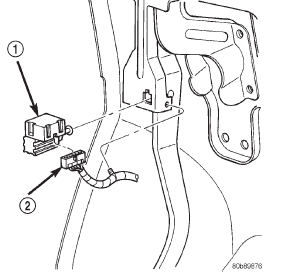
Fig. 17 Brake Lamp Switch
2 - HARNESS CONNECTORBrake pedal
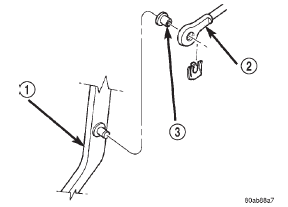
Fig. 18 Booster Push Rod
2 - BOOSTER ROD
3 - BUSHINGCombination valve
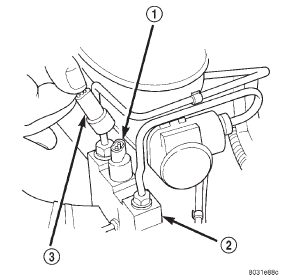
Fig. 19 Differential Pressure Switch
2 - COMBINATION VALVE
3 - WIRE HARNESS CONNECTOR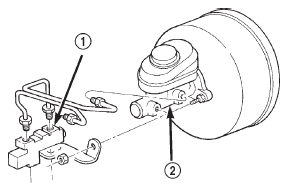
Fig. 20 Combination Valve
2 - MASTER CYLINDERMaster cylinder
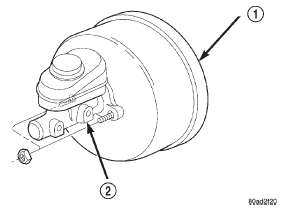
Fig. 21 Master Cylinder
2 - MASTER CYLINDERPower brake booster
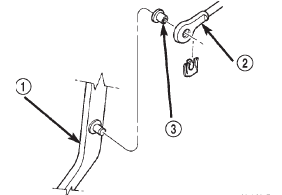
Fig. 22 Booster Push Rod
2 - BOOSTER ROD
3 - BUSHING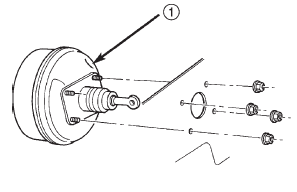
Fig. 23 Booster MountingFront disc brake caliper
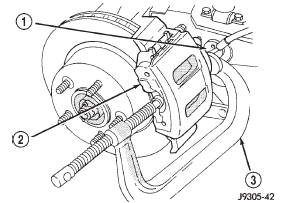
Fig. 24 Bottoming Caliper Piston With C-Clamp
2 - OUTBOARD BRAKESHOE
3 - C-CLAMP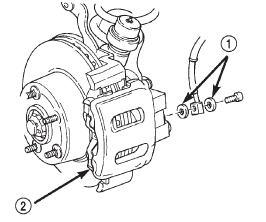 БЮ
Fig. 25 Brake Hose And Bolt
БЮ
Fig. 25 Brake Hose And Bolt
2 - CALIPERS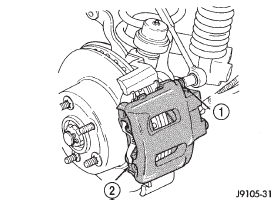
Fig. 26 Caliper Mounting Bolts
2 - CALIPER
Fig. 27 Caliper Removal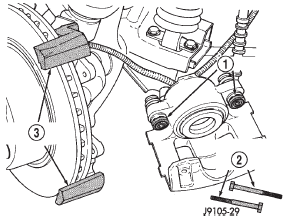
Fig. 28 Caliper Lubrication Points
2 - CALIPER MOUNTING BOLTS
3 - MOUNTING LEDGES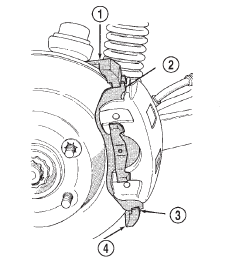
Fig. 29 Caliper Installation
2 - BRAKESHOE TAB ON LEDGE OUTER SURFACE
3 - LEDGE SEATED IN BRAKESHOE NOTCH
4 - BOTTOM LEDGE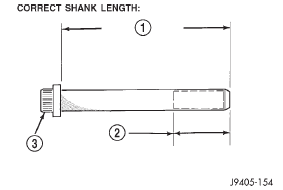
Fig. 30 Mounting Bolt Dimensions
2 - 22 mm (0.866 in.) THREAD LENGTH
3 - CALIPER BOLTFront disc brake shoes
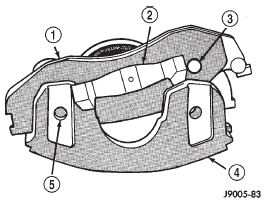
Fig. 31 Outboard Brake Shoe Removal
2 - SHOE SPRING
3 - LOCATING LUG
4 - CALIPER
5 - LOCATING LUG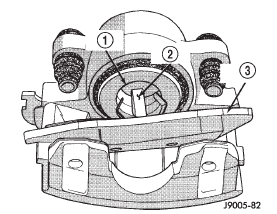
Fig. 32 Inboard Brake Shoe Removal
2 - SHOE SPRINGS
3 - INBOARD BRAKESHOEDisc brake rotor
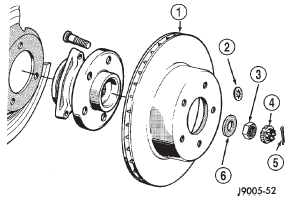
Fig. 33 Rotor & Hub
2 - RETAINER
3 - BEARING NUT
4 - NUT LOCK
5 - COTTER PIN
6 - WASHERDrum brake shoes
Wheel cylinder
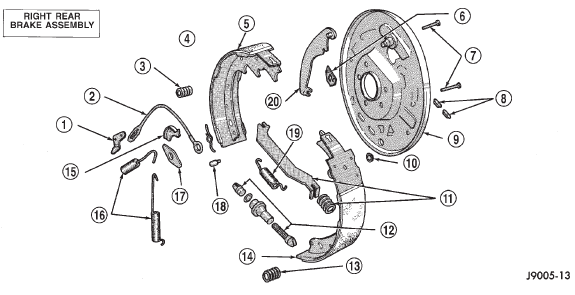
Fig. 34 Drum Brake Components-Typical
2 - ADJUSTER CABLE
3 - HOLDDOWN SPRING AND RETAINERS
4 - ADJUSTER LEVER SPRING
5 - TRAILING SHOE
6 - CYLINDER-TO-SUPPORT SEAL
7 - HOLDDOWN PINS
8 - ACCESS PLUGS
9 - SUPPORT PLATE
10 - CABLE HOLE PLUG
11 - PARK BRAKE STRUT AND SPRING
12 - ADJUSTER SCREW ASSEMBLY
13 - HOLDDOWN SPRING AND RETAINERS
14 - LEADING SHOE
15 - CABLE GUIDE
16 - SHOE RETURN SPRINGS
17 - SHOE GUIDE PLATE
18 - PIN
19 - SHOE SPRING
20 - PARK BRAKE LEVER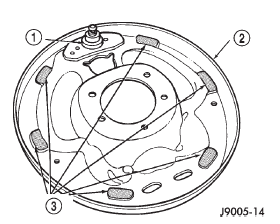
Fig. 35 Shoe Contact Surfaces
2 - SUPPORT PLATE
3 - SHOE CONTACT SURFACESBrake support plate
Rear parking brake cables
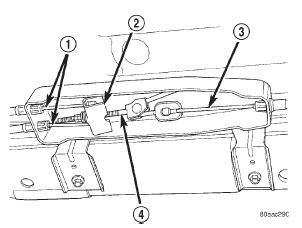
Fig. 36 Parking Brake Cables
2 - EQUALIZER
3 - FRONT CABLE
4 - TENSIONER ROD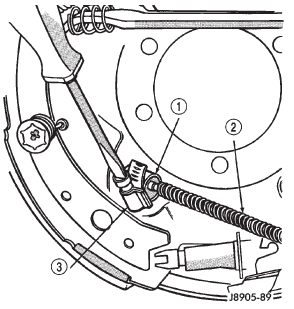
Fig. 37 Cable Retainer
2 - REAR CABLE
3 - WORM DRIVE HOSE CLAMPParking brake lever
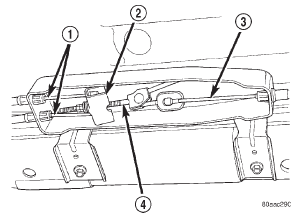
Fig. 38 Parking Brake Equalizer
2 - EQUALIZER
3 - FRONT CABLE
4 - TENSIONER ROD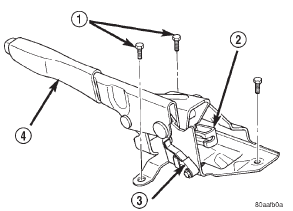
Fig. 39 Parking Brake Lever Assembly
2 - FRONT CABLE LEVER
3 - PARKING BRAKE SWITCH
4 - PARKING BRAKE LEVER
Other materials:
Heater-A/C housing
The heater-A/C housing assembly must be removed
from the vehicle and the two halves of the housing
separated for service access of the heater core, evaporator
coil, blend-air door, and each of the various
mode control doors.
WARNING: ON VEHICLES EQUIPPED WITH AIRBAGS,
REFER TO GROUP 8M - PASSI ...


